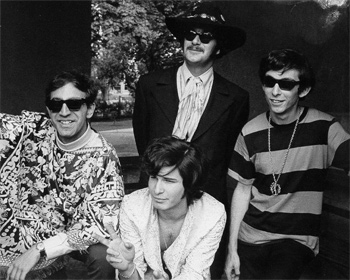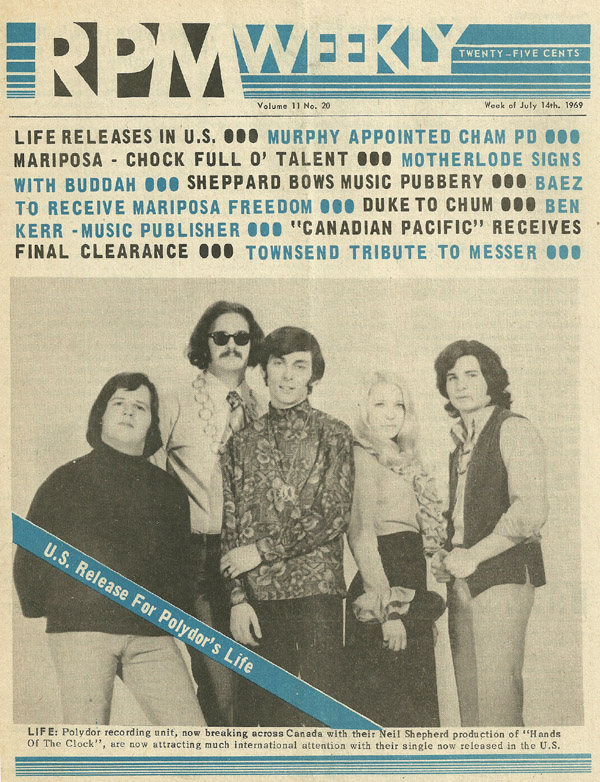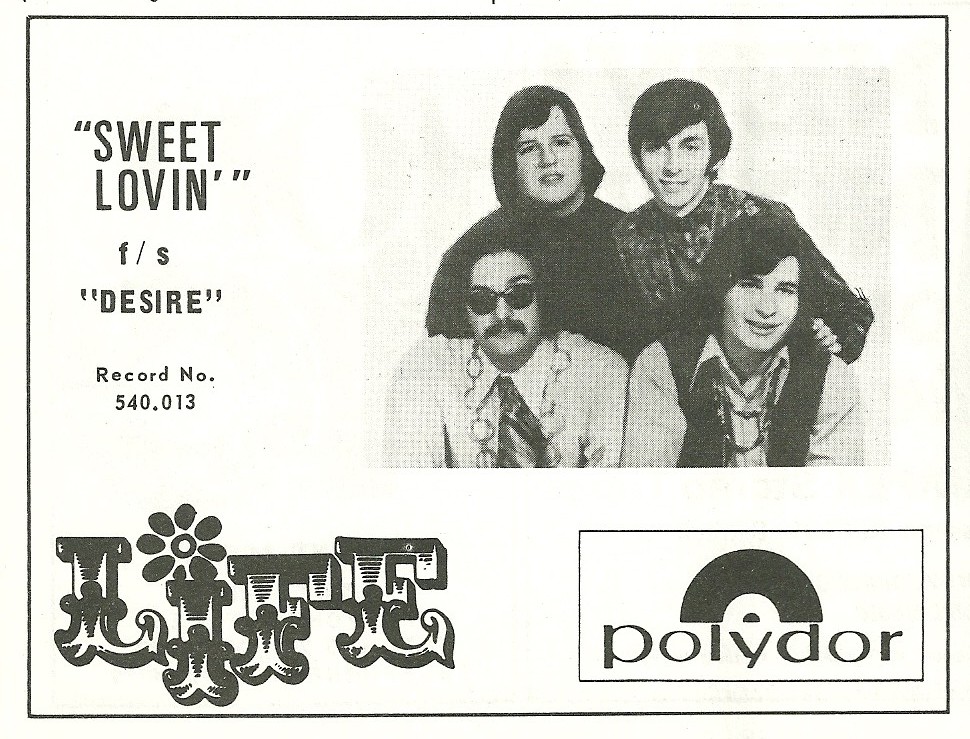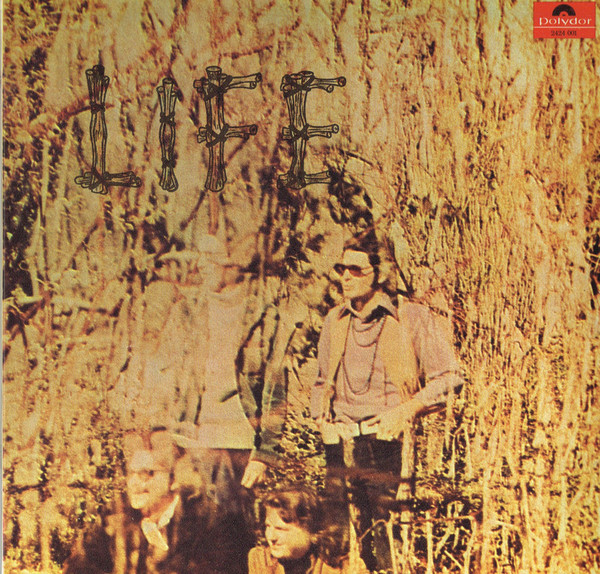By Nick Warburton
In the early 1970s Montreal musicians Neil Sheppard and Marty Simon moved to London to pursue new musical opportunities. Singer/songwriter and producer Neil Sheppard recorded an unreleased LP for RCA that featured contributions from the likes of Peter Frampton and John Entwistle. He also spent time writing for singer Long John Baldry. Drummer Marty Simon meanwhile recorded with Sharks, the band formed by ex-Free bass player Andy Fraser and session guitarist Chris Spedding.
During the late 1960s, the pair had worked together with Montreal band Life, who recorded a criminally overlooked and rare LP for Polydor Canada. Nick Warburton tells the story.

Few people took notice when Montreal band Life’s lone eponymous album slipped out on Polydor Records Canada in March 1970. Arguably one of the era’s most obscure releases, it has taken decades for listeners to finally discover this criminally overlooked record through a 2016 bootleg CD release (an original LP copy will set you back a hefty amount on Discogs!).
Take the incredibly crisp production, which is head and shoulders above the quality of most of the Canadian albums recorded at that time (not to mention many of those by the band’s American and British contemporaries). Then, there is the (largely) exceptionally strong and highly original material, brilliantly arranged and executed with aplomb.
Packed full of inventive ideas, not to mention dazzling sound effects, Life is a superlative record that fuses together jazz, funk, soul, psychedelia and rock effortlessly.
Life (the album) was the brainchild of Montreal native Neil Ship (aka Neil Sheppard), an incredibly talented singer/song-writer (and part of the Brill Building stable), who was looking to get his songs recorded with a group.
In 1960, at the precocious age of 14, he’d scored a deal with Columbia Records in New York and recorded a long lost gem “Beyond the Shadow of a Doubt” c/w “In My Imagination”.
After years working in the Big Apple, where he amassed a wealth of experience in production, arrangement and song-writing, Sheppard landed a deal with Polydor Records Canada and started to put together a band to record his songs.
Sheppard had several musicians in mind for the Life project. First on the list was one of his brothers, keyboard player and singer Michael Ship, who was working in Montreal band, The Scene alongside bass player Danny Zimmerman, drummer Marty Simon and two long forgotten guitarists. The quintet had been around on “the scene” for a number of years and had evolved out of earlier bands, The Humdingers and (before that) Marty Simon and The Capris.
During his time in New York, Sheppard had met Hank Medress and The Tokens, owners of the Bt (Bright Tunes) Puppy label, and had done some studio work for them. In late 1967, he helped his brother by landing a one-off single deal for The Scene, which resulted in the psychedelic pop outing “Scenes (From Another World)” c/w “You’re In a Bad Way”.
While the single didn’t really do much chart wise, Sheppard was excited by the band’s potential and felt an album was an obvious progression. In late 1968, he linked Scene members – Michael Ship, Marty Simon and Danny Zimmerman with lead guitarist Barry Albert, a veteran of Bartholomew Plus Three.
Formed by Albert with another of Sheppard’s brothers, keyboard player and singer Gary Ship (aka Gary Gardos), Bartholomew Plus Three also comprised bass player George Gardos and drummer Corky Laing.
Albert’s band had released two singles for the Toronto-based Quality Records label in 1965-1966 before switching to Can-Am for two further releases.
Thanks to Sheppard’s efforts in New York, Bartholomew Plus Three got the opportunity to record some material for Atlantic Records with Cream’s producer Felix Pappalardi at the helm. A single coupling “When I Fall in Love” c/w “I Can’t Go Back” came out in November 1967 and even became a minor Canadian hit, peaking at #80.
The band (sans Albert) became Energy and recorded an LP that tragically was never released.
In 1969, Pappalardi poached Laing for Mountain and the drummer composed that band’s hit “Mississippi Queen”. Born in London, England, Albert had moved to Canada at an early age and met Sheppard during his teenage years. According to the guitarist, the concept for the songs behind the Life project stemmed from conversations they had had in early 1969.
“Neil and I were musical buddies from the time we were 16 and planned every move,” he says. “I picked the tunes from what he wrote and then we changed the name of the band to Life. We were trying to accomplish what we had done with Bartholomew Plus Three, except this time we used a studio in Montreal instead of New York.”
According to Marty Simon the band used a small rehearsal room in the basement of a building on Pine and St Laurent Boulevard to perfect the material. Once the songs were ready to cut in the studio, recordings took place at Stereo Sound Studios, a state of the art recording complex owned by RCA on Cote des Neiges.
In an interesting side note, the studio also housed a rehearsal room in the basement, which in April 1968, was the scene of an informal jam with Jimi Hendrix.
“My manager/agent for Bartholomew Plus Three had booked Jimi into one of the Montreal arenas and after the show got him to our studio,” says Albert.
“Word got out and there was a line-up around the block – we had a stage there and room for approximately 35 people. Marty, Danny and Michael were our friends and The Scene was there.”
While the album would take several months to record and perfect, the basic tracks were recorded very quickly over a matter of days, says Simon.
“It was after that when Neil would work with Michael on vocals and ask me to contribute bongos, vocals and even a melody line in the middle solo for ‘Ain’t I Told You Before’. I believe that Neil played the piano on ‘Needing You’, the last track we recorded.”
The first song recorded for the Life project, and the opening cut on the album was Sheppard’s brilliant “Hands of the Clock”, a powerful rock ballad that the composer had conceived one night at the Winston Churchill pub in Montreal.
“Every night the place closed at about two or three in the morning and I remember I used to come in and sit down at the organ and start writing,” says Sheppard. “One night I just sat down and that love song popped up.”
“‘Hands of the Clock’ was a project started by Neil and myself,” adds Albert. “I told Neil it would take six months after I picked the song but he was in a hurry so we did it in three months even though I wasn’t happy about the tightness or the vocals.”
Sheppard did most of the production on “Hands of the Clock” and Albert helped out with the arrangement. The incisive and stunning guitar work that punctuates the song was not planned according to the guitarist. “I fluked a pretty good guitar lead, which was created in the studio like a jam session,” says Albert.
Released as the band’s debut single in June 1969 (although the catalogue lists it as the second release), “Hands of the Clock” became a modest hit, reaching #19 on the national RPM chart two months later.
In the aftermath of the single’s release and its rise up the charts, Life played its biggest concert of its short-lived career – the First Montreal Bi-Cultural Pop Festival, held at the Montreal Forum alongside Triangle, Robert Charlebois and headliners Steppenwolf.
“It was the first time a local act had been billed in the 20,000 seat hockey arena,” says Simon. “[We were] hometown boys making good.”
With “Hands of the Clock” in the can, Albert insists that he only remained long enough to lay down a guitar part to the bed track of one other song – the dazzling horn-driven jazz rocker, “Ain’t I Told You Before”.
“Marty had exceptional feel – one of the best drummers I ever worked with,” says Albert looking back. “[However] I only remember doing those two cuts.”
Dissatisfied with the way the recordings were progressing (and the arrival of second guitarist Jean Pierre Lauzon), Albert made his excuses and left to join label mates Tapestry, another promising band fronted by singers Jack Winters, Judy Harmon and Heather Woodburn.
Albert’s recollections of recording these two tracks chime with Simon, although the drummer is sure that the guitarist did provide bed tracks to several other songs before leaving. (Ed. The LP’s back cover also identifies a number of songs featuring his guitar work.)
Indeed, several of the songs, most notably the brilliantly funky “Sweet Lovin’” – to this listener one of the album’s highlights – definitely features the work of two guitar players beautifully trading off each other.
“I don’t think I ever did a session with JP [Lauzon] but I think I did other tracks and he dubbed at another time,” says Albert. (Ed. Guest guitarist Bill Hill is also listed on a few tracks.)
In an interesting turn of events, Lauzon had succeeded Albert in Bartholomew Plus Three and Energy when the guitarist had left to become a member of Life. Lauzon had previously worked with a number of notable Montreal bands, including Our Generation, J B and The Playboys, The Jaybees and The Carnival Connection.
Another addition to two of the album’s songs was Zimmerman’s wife Lorraine Niedzielski (aka Neid), who had been working with Montreal band, The Munks. As Simon recalls, Neid sang the chorus on “Ain’t I Told You Before” and contributed joint lead vocals on the band’s cover of The Beatles’ “Strawberry Fields Forever”. (Ed. Another female Canadian singer Frankie Hart also appears on the LP.)

Life’s interpretation of this Beatles’ classic is a real revelation. Imbued with a strong jazz feel, the track is notable for Lauzon’s exquisite flamenco guitar solo.
“I heard JP playing a particularly jazzy guitar chord and I heard a full arrangement in my head and immediately started telling people where to jump in and play some music,” says Simon, who arranged the basic form and style of the cover.
“After we had a progression of sorts, I revealed what my idea was – they would have laughed if I had mentioned the track beforehand – when I began to sing ‘Strawberry Fields’ and we knew we had something there!”
With a beautiful horn arrangement by Sheppard, and graced by a superb guitar lead from Lauzon, the track was released in an edited form as the band’s second single (but incidentally with a catalogue number that predates “Hands of the Clock”).
With hit record written over it, “Strawberry Fields Forever” should have been the international breakthrough for Life but remarkably didn’t even trouble the Canadian charts.
Even so, that didn’t stop Polydor releasing the single in several European countries, including Germany where the 45’s picture sleeve features Lorraine Neid on the cover. By this point, Danny’s wife had become a fully-fledged member and would tour with the band throughout the latter months of 1969.
As Lorri Zimmerman, Neid would subsequently record an eponymous LP for Crescent Street Records in 1971, which has been issued on CD by the Fallout label. She also recorded a string of singles, including one with her husband under the name Lorri Zimmerman & The Vegetable Band. Zimmerman later recorded with the group Toulouse.
As strong as the album is, however, not all of Life stands up so well after all these years. In particular, Sheppard’s “Desire” (also covered by his brother’s band Energy but never released), with its rather jarring “Kiss Me” refrain, and “Come To Me” are not in the same league as the song-writer’s “Hands of the Clock”, “Sweet Lovin’” and “Needing You”, not to mention the band’s covers of “Strawberry Fields Forever” and “Lovin Time”, a Terry Reid song performed by Simon’s pre-Life band, The Scene.
“‘Lovin’ Time’ was a cover of an original version that Danny Zimmerman and I discovered on a Terry Reid album,” explains Simon. “Life performed this song so well with its rhythm changes that we decided it would be great to record it on the record.”
Also worth checking out are the two instrumentals penned by the band members that bookend and kick off sides one and two – “Lifetime 1” and “Lifetime 2” both have a sonic charm and feature some impressive backwards guitar, courtesy of J P Lauzon.
Equally impressive is the closing number, Sheppard’s “Needing You”, featuring the composer on keys. A haunting ballad with sumptuous piano work and aching strings, it is a fitting ending to a largely brilliant album.
With the basic tracks recorded at Stereo Sound Studio, additional work was done over the next few months to enhance Sheppard’s superlative production work.

“Those tracks were transferred to a home studio owned by Andre Perry, a Montreal studio wizard who had the first eight track recorder in Canada,” says Simon. “Neil was meticulous in getting the large colours of Life’s rock band core instruments, vocals, cellos and other overdubs to hold together and the eight track recording helped provide the space and mix.”
Perry, who would soon after record John Lennon and Yoko Ono’s “Give Peace A Chance” at their “bed in” at the Queen Elizabeth Hotel in Montreal, played a significant role in taking Sheppard’s brilliant production to the next level.
It also didn’t hurt that Polydor had been generous enough to give Sheppard a sizeable budget to cut the album. “I think we had a $7,000 budget,” he says. “It was like a million dollars today.”
While completing the final overdubs for the album, Sheppard received a visit from former Influence drummer Frank LoRusso (affectionately known as Yum Yum), who brought with him Englishman Malcolm Tomlinson.
Originally from west London, Tomlinson had until recently been working with guitarist Martin Barre in a succession of bands that culminated in Gethsemane and in October 1968 did a radio session with Elton John for the BBC. When Barre joined Jethro Tull that December, Tomlinson moved to Toronto in early 1969.
Since arriving in Canada, Tomlinson had been a member of Anglo-Canadian band Milkwood and added a wonderful flute solo to Life’s “Lovin’ Time”.
“He [Tomlinson] was hanging around the studio and had worked on something recently [Jay Telfer’s unreleased LP Perch as well as Milkwood’s unreleased LP for Polydor produced at the Hit Factory in New York with Jerry Ragavoy]” says Sheppard. “He asked if he could stay for the session. We developed a flute part and I asked him if he wanted to come out and do it. It was a last minute thing.”
With the album readied for release, Life, joined by guitarist Bill Hill, a friend of Lauzon’s from his days with The Playboys, The Jaybees and Carnival Connection who had guested on some of the album tracks, hit the road. However, soon after the LP’s release in spring 1970 the band imploded when Simon left for New York.
“I did not see a future in Montreal or, without a manager that could take the group forward,” says Simon who quit joining gospel-rocker Mylon LeFevre with JP Lauzon.
“Corky [Laing] called me when Mountain’s management was putting together a band for Mylon in Atlanta. By 1970, Corky had a huge hit and Mountain was headlining and I was drumming in Mylon’s band, Holy Smoke, in the studio with Jerry Wexler, Tom Dowd and opening a cross country tour with The Who. Talk about your dream coming true.”
Then in 1972, Simon moved to London and played in Sharks with Andy Fraser from Free and top session guitarist Chris Spedding. While there he played on Brian Eno’s debut solo album and also worked with Mick Jagger and Jimmy Page, among others.
Back in Canada, Simon recorded with April Wine, co-wrote and played on Wilson Pickett’s 1980 album I Want You, and co-wrote Celine Dion’s French language hit, “Des Mots qui Sonnett” before later gaining success as a composer for feature films and TV shows.
The founding director of MRD-Music Revenue Data Inc, Simon administers publishing catalogues worldwide for hundreds of Film and TV programmes, including Capote, Being Julia and Ryan, the 2005 Academy Award winner for Best Short Film. He also serves on SOCAN’s board as a film and TV music publisher. Most recently, MRD tracked down composers Tom Holkenborg (JunkieXL) and Harry Gregson Williams who have joined its roster.
Like Simon, Neil Sheppard also spent time in the UK during the early 1970s where he worked at Carlin Music and recorded a solo album for RCA (with Barry Albert) provisionally entitled If It’s Heavy, Put it Down.
The solo set, which was subsequently scrapped, featured contributions from noted session bass player Herbie Flowers, Sheppard’s friend John Entwistle from The Who, drummer Jim Gordon and guitarists Ray Cooper, Davey Johnstone and Peter Frampton among others. Only two tracks saw the light of the day, paired for a single, “Brighter Day” c/w “Heaven Held”. The tapes currently sit with Sony.
Undeterred by the setback, Sheppard began working with American singer/songwriter Tim Hardin and contributed the song “Till We Meet Again” to Tim Hardin’s 1974 album Painted Head (Ed: he also added piano and harmonium and did the production).
Back in New York by the mid-1970s, Sheppard wrote the hit single “Let’s Call It A Day Girl” for The Razors Edge, which was also recorded by Bobby Vee and The Four Preps. Not only that but he’s seen his songs covered by everyone from The Everly Brothers to Gene Pitney, Long John Baldy and Herbie Mann, to name just a few.
As innovative as ever, he also scored an underground disco hit in the late 1970s when The Love Symphony Orchestra recorded “Let Me Be Your Fantasy”. Like Simon, he also extended his talents into TV work and wrote the documentaries The World of Horses and Do Blonds Have More Fun.
As successful as they have both been, Life remains a cherished experience for Sheppard and Simon. In 2016 a Japanese bootleg version of the LP with an alternate version of “Desire” and a comedy track “Looney Tune” added to the track running came out on CD.
A bona fide CD re-issue of the Life LP with liner notes is long overdue and it would also be great to see Sheppard’s British solo recordings from the early 1970s also given a release. Sadly, Sheppard never got to see either; he died in his sleep in New York City on 22 May 2021.
Speaking to this writer long before his death, Sheppard had this to say: “I can only remember trying to make a great album at the time, doing whatever I could to make my concept come alive, yet remain as natural and unsynthetic as possible. It wasn’t a worldwide hit record but it was an honest attempt at creating an impression of the period that I am still quite proud of.”
Huge thanks to Neil Sheppard, Marty Simon and Barry Albert. Thanks to Ivan Amirault for scans of promotional material on Life. The photo at the top is from the Marc Denis’ Rock Radio Scrapbooks.
This is an updated version of an article that was originally published on the Nick Warburton website on 26 February 2011.
Copyright © Nick Warburton. All Rights Reserved. No part of this article may be reproduced or transmitted in any from or by any means, without prior permission from the author

